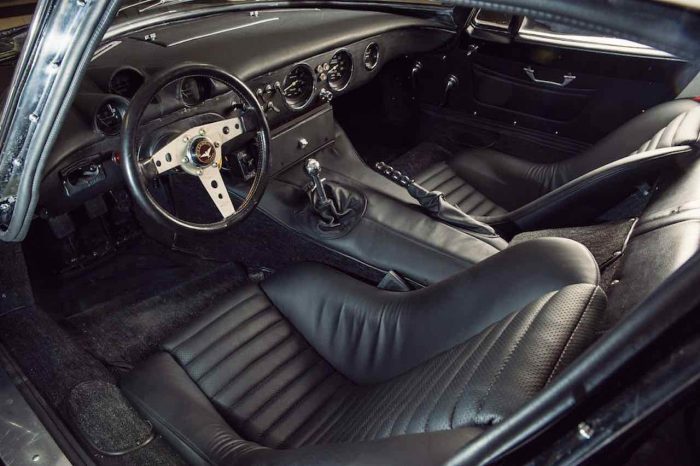Bizzarrini GT Strada 5300, medio hermano del Ferrari 250 GTO
Giotto Bizzarrini fue un ingeniero y piloto de pruebas del que muchos, salvo los más acérrimos aficionados a la historia del automovilismo, nunca han oído hablar. De hecho, él mismo prefirió siempre permanecer en el cómodo anonimato. Una de sus más memorables frases era “No soy un diseñador de coches, soy un trabajador”. La mejor prueba de ello fue que no paró un momento de trabajar desde que se graduó en la Universidad de Pisa en 1953.
El de Livorno trabajó como nadie en este coche, el mejor deportivo de los años 50. En la parte de diseño, de ingeniería y de prueba del resultado final. La década siguiente abandonaría la Scudería, en 1961, en la “Gran Salida” y fundó Automobili Turismo e Deporte (comúnmente conocido como ATS) para fabricar coches de carreras y coches de calle. Poco después fundaba su propia compañía, Società Autostar, cuyo nombre el nombre simplemente “Bizzarrini”.



De los vehículos a luz a su propio nombre, el más famoso es el coche que ves aquí el Bizzarrini GT Strada 5300. El diseño se tomaba como base su trabajo anterior en con el Iso Grifo, hasta la estructura monocasco era casi idéntica (en realidad, podíamos definirlo como un Grifo con 2+2 plazas, si bien entrar al coche, con esos 109 cm de altura, era labor compleja).
Gioto optó por utilizar el potente y fiable bloque “pequeño” V8 del Chevrolet Corvetta, que tenía 5.358 cc de cilindrada y podía enviar más de 365 CV de potencia a las ruedas traseras mediante una caja de cambios BorgWarner T-10 de 4 velocidades. Tenía una suspensión delantera independiente con brazos oscilantes, muelles helicoidales, amortiguadores telescópicos y una barra estabilizadora, mientras que el eje trasero tenía una suspensión de eje de Dion (con la transmisión fijada al chasis). No faltaba un diferencial de deslizamiento limitado y frenos de disco en las cuatro ruedas.

El Bizzarrini GT Strada 5300 se fabricó de 1965 hasta 1968, tiempo en el que se fabricaron unas 133 unidades, incluyendo un spyder. Muchos fueron modificados para competir codo con codo con los Ferrari de la época… y a menudo acababa por delante de ellos cuando caía la bandera a cuadros.
Este Bizzarrini GT Strada, número de chasis 0248, se tituló por primera vez en Italia en 1966, aunque su propietario original no se conoce. Se cree que es una de las primeras unidades, con una carrocería de aleación. Se cree que el coche compitió por toda Italia en los 60 y 70 y, tras pasar por varias manos, acabó en la Colección Fendt en 2007. Totalmente restaurado entre 2008 y 2019, con ligeras modificaciones mecánicas… pero se mantuvo el color negro, con llantas doradas, tal como aparece en las fotografías históricas.
---------------------------------
Giotto Bizzarrini was an engineer and test driver of which many, except the most staunch amateurs in motorsport history, have never heard of it. In fact, he himself always preferred to remain in comfortable anonymity. One of his most memorable phrases was "I'm not a car designer, I'm a hard worker." The best proof of this was that he did not stop a moment of work since he graduated from the University of Pisa in 1953.
Bizzarrini is currently a professor at the University of Rome and works developing, designing and building sports cars together with other professors and students. Almost completely safe (hopefully we are wrong), none will reach the level of his great masterpiece, a car that, curiously, does not bear his name, the Ferrari 250 GTO.
Livorno worked like nobody else in this car, the best sports car of the 50's. In the design, engineering and testing part of the final result. The following decade would leave the Scuderia, in 1961, in the "Great Exit" and founded Automobili Tourism and Sport (commonly known like ATS) to make cars of races and street cars. Shortly after founded his own company, Società Autostar, whose name the name simply "Bizzarrini".
Bizzarrini GT Strada 1966 - 6
Bizzarrini GT Strada 1966 - 1
Bizzarrini GT Strada 1966 - 5
From vehicles to light to its own name, the most famous is the car you see here the Bizzarrini GT Strada 5300. The design was based on his previous work in with the Iso Grifo, until the monocoque structure was almost identical (actually , We could define it as a Griffin with 2 + 2 seats, although entering the car, with those 109 cm in height, was complex work).
Gioto opted to use the powerful and reliable "small" block V8 of the Chevrolet Corvetta, which had 5,358 cc of displacement and could send more than 365 CV of power to the rear wheels by a BorgWarner T-10 4-speed gearbox. It had a separate front suspension with swing arms, coil springs, telescopic dampers and a stabilizer bar, while the rear axle had a Dion axle suspension (with transmission attached to the chassis). There was no shortage of limited slip differential and disc brakes on all four wheels.
Bizzarrini GT Strada 1966 interior - 1
The Bizzarrini GT Strada 5300 was manufactured from 1965 to 1968, at which time some 133 units were manufactured, including a spyder. Many were modified to compete side by side with the Ferrari of the time ... and often ended up ahead of them when the checkered flag fell.
This Bizzarrini GT Strada, chassis number 0248, was titled for the first time in Italy in 1966, although its original owner is not known. It is believed to be one of the first units, with an alloy body. It is believed that the car competed throughout Italy in the 60s and 70s and, after passing through several hands, ended up in the Fendt Collection in 2007. Completely restored between 2008 and 2019, with slight mechanical modifications ... but the color remained black, with Golden rims, as it appears in the historical photographs.
No comments:
Post a Comment